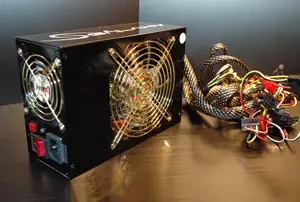Invest into proper power protection
What works for your microwave oven should be fine for your computer, right? So, many, who buy themselves a new computer are tempted to just plug in that investment into a $5 power strip.
Don’t do that.
While the power from the wall might be good for your toaster, your computer is a very delicate piece of technology. Think of the electricity in your computer as the blood that pumps through your own veins. Obviously, a smooth and regular flow of blood will make you work your best, and the same goes for your computer. Your computer is very sensitive to bad electricity and needs a nice smooth clean flow of power.
But the electricity coming straight from your wall can often vary an awful lot. Even little changes in voltage over time can cause the parts in your computer to fail. Many rural areas and some older apartment buildings are well known for having very unstable power. If you notice your lights flicker from time to time, that’s usually a sign of unsteady power. But even if you don’t notice voltage changes that dramatically, your computer will. It’s much more sensitive to changes in the electricity going into it.
The cord on your computer that you plug into the wall leads directly to what is called the computer’s Power Supply. The Power Supply turns the electricity from the wall into electricity the computer’s different parts can use. As a result, the poor Power Supply takes the brunt of any jumps and bumps in electricity. Eventually, your Power Supply will grow weak from these and fail. Worst yet, it might do so at a time that you might be in the middle of using the computer.
You wouldn’t want the computer to turn off halfway through a doing project or writing a letter, would you? Not only would you would lose whatever you were doing, but the sudden drop in power can cause parts like your hard drive and motherboard to also die.
Replacing these parts will be both expensive and difficult, not to mention losing important data. Your investment would be lost at the hands of a $5 power strip.
But there are things you can do to protect your investment. The absolute cheapest option is to buy a Surge Protector. These bars will cut the power to your computer of if the current jumps too high, like in a lightning strike, protecting your computer. They usually sell for about $30 – $40, and usually will state on the box that they are Surge Protectors.
Many offer guarantees and warranties if they don’t work. But while they are better than a $5 power strip, but they still allow all the little changes in power to pass through. You may be saved from the big whallop, but your computer still may fail from the little bumps and jiggles in voltage.
Another, and far better, option is to buy what is known as an Uninterruptible Power Supply, or UPS. A UPS is really just a big battery that’s charged from the wall. Your computer draws power from the battery all the time, while the household current keeps it charged. The benefit is that while also adding Surge Protection, your computer always gets the exact same voltage all the time. Clean power means longer lasting parts, as well as less tears and hair pulled out.
Most UPS devices also sense when the power has gone out, as in a storm, and will properly shut down your computer once the battery runs too low. This can give you just enough time to finish and save what you are doing. A UPS can sell from anywhere between $60 – $200 depending on the battery size and power.
Allowing your computer to run off of bad electricity is like putting cheap gas in to your high-performance sports car. Both are not good ideas. And given what your computer cost to buy in the first place, isn’t it worth it?
You can get your own UPS from the following retailers:

